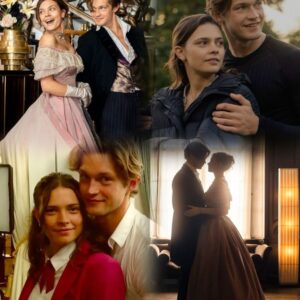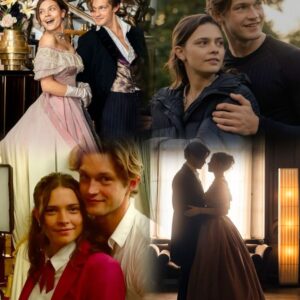
(Prime Video / Netflix)
Dearest gentle reader, there is no gentle way to say this, but I shall endeavour to: Bridgerton season 3 was rather mid. And the ball it dropped was picked up by another swoon-worthy romance series that is also based on a book, My Lady Jane.
And so here it goes, an unpopular opinion that is going to sting like a bee.
My Lady Jane > Bridgerton 3
Now, I don’t say this lightly. Bridgerton is my favorite escapist fantasy. After a pathbreaking first season and a second season that set the gold standard in yearning and enemies-to-lovers romance, to say the expectations from season 3 were high would be an understatement. More so, because this was Polin season; the one where THE Lady Whistledown, Penelope Featherington, finally stopped being a wallflower and got her crush, Colin Bridgerton, to love her back.
As a writer, a plus-size girl often judged for her appearance, and some who has had to forfeit a lot of crushes because I never thought they’d like me for me, I sought catharsis from Bridgerton 3. And some of it was found. I loved Penelope and the Featherington family’s arcs this season and the queer-coded friendship between mean girl Cressida Cowper and Eloise Bridgerton. The sex scenes between Polin were so thoughtful and sensitive, giving mainstream representation for people like me (with bigger bodies) like never before.
 (Netflix)
(Netflix)
And yet, this was the weakest of the three seasons in terms of writing, character development, and subplots. Colin’s character was severely underwritten; he deserved more as the lead! The subplot with the Mondrichs felt lackluster and given too much footage, while the Viscount and Viscountess had simply not enough.
The world of Bridgerton allows itself historical inaccuracies in how London society functions, and we don’t question it as long as it makes for engaging storytelling. Yet this season, with the Viscount—the head of the family—not being present at his own sister’s nuptials, or Colin and Penelope’s several unchaperoned meetings that absolutely nobody in this gossip loving-ton took note of… it all became irksome doubts when the story didn’t keep us occupied.
Do not even get me started on Netflix splitting the season into two parts, because the way it broke the flow when things were just getting fun was unforgivable! All the best episodes of the season are in the second part!
Why is My Lady Jane Superior to Bridgerton season 3?
 (Prime)
(Prime)
Amidst my lukewarm feelings about Bridgerton, My Lady Jane on Prime galloped into my life. And I was swept away from episode 1. The promos had already caught my (and other romance-loving book girlies’) fancy with the palpable chemistry and “lust at first sight” between Emily Bader and Edward Bluemel, who play the leads Lady Jane Grey and Guildford, respectively. And the season didn’t disappoint!
Like Bridgerton, My Lady Jane too is an eight-episode season. Set in 1553 England, a couple of centuries before the events of Bridgerton and infinitely more salacious, My Lady Jane is a feminist reclaiming of the story of Jane Grey, a British noblewoman and cousin to King Edward VI of Britain, who was named heir by him before his death, and became a queen for nine days before she was dethroned and executed for high treason.
Upon bingeing the entire season, I found that My Lady Jane had the superior chemistry between its leads. Despite this being a slow burn, and there being one less, and less explicit, sexual encounter than Bridgerton, My Lady Jane made me feel profusely hot with everything that was happening between Jane and Guildford. There was yearning—oh so much yearning—in My Lady Jane, a sentiment that Bridgerton had made its USP over the last two seasons but was conspicuously missing from its third season.
The banter between Jane and Guildford is *chef’s kiss* There’s a scene where Jane throws water on Guildford’s face, and what she does when he tries the same on her and misses is simply epic! I love the fact that Guildford actually marries Jane because he finds out she is smart and a polyglot (someone who knows several languages), and they address this in the show with a hilarious reaction from Jane. In Bridgerton, I missed a little more time being spent on Pen and Colin as writers, and her being so clever and good at what she does.
My Lady Jane is outrageously funny, thanks to its narrator (whose identity might come as a surprise to you) and its well-written supporting acts. Anna Chancellor as Lady Frances Grey, mother to Jane, reminded me of Polly Walker’s Portia Featherington with her sharp jibes, deft navigation of the social circle, strategic mind, and survival skills as a widowed mother of three daughters.
The subplots about a queer king of Britain and Ethian (humans who can turn into animals) rights, the historical inaccuracies and modern spins, all of it contributed to more than just engaging storytelling—it made for better socio-political commentary too. That’s not to say I’d prefer a history lesson from Bridgerton, no ma’am. But that My Lady Jane was all that and still managed to be a swoony romance speaks volumes of just how well it was written.
Oh, and nobody decided to split the season in two parts. That might’ve just been the biggest point in My Lady Jane’s kitty over Bridgerton’s.
 (Prime Video)
(Prime Video)
Look here, I still love Bridgerton. Penelope is always going to be a hero who seized opportunity instead of being victim to her circumstances. And you best bet I will be seated for all seasons right up till it’s Gregory and Hyacinth’s turn (even if the other siblings can’t make it because, you know, the actors are not available or not given proper scenes).
But My Lady Jane totally crushes this round, giving us a feminist heroine we can root for, a new fictional man to desire, and a romance that can get your hurt fluttering with banter and acts of service, all the while commenting on England’s politics circa the 1550s.
That’s a winning horse, right there!





